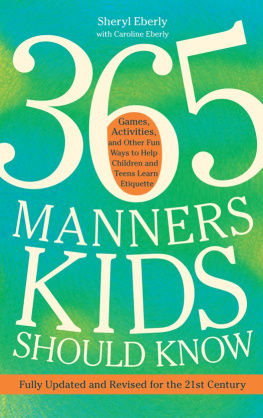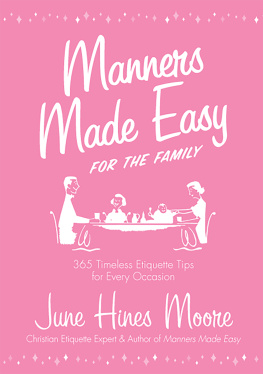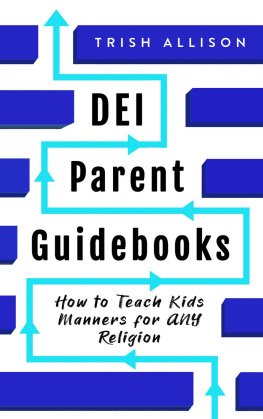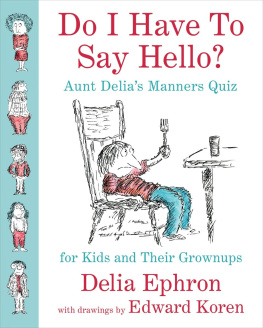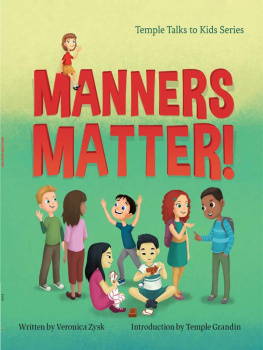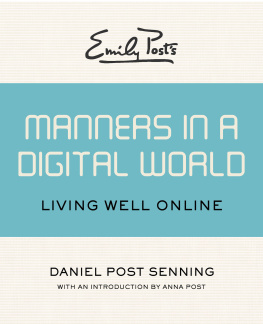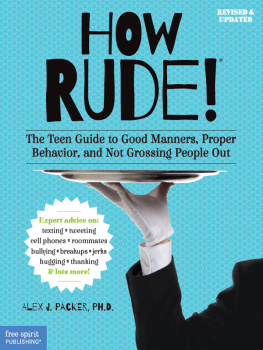
Copyright 2001, 2011 by Sheryl Eberly
All rights reserved.
Published in the United States by Three Rivers Press, an imprint of the Crown
Publishing Group, a division of Random House, Inc., New York.
www.crownpublishing.com
Three Rivers Press and the Tugboat design are registered trademarks of
Random House, Inc.
Originally published in paperback in slightly different form in the United States by
Three Rivers Press, an imprint of the Crown Publishing Group, a division of
Random House, Inc., New York, in 2001.
Library of Congress Cataloging-in-Publication Data
Eberly, Sheryl.
365 manners kids should know : games, activities, and other fun ways to help children and teens learn etiquette / Sheryl Eberly with Caroline Eberly.1st ed.,
[2nd ed.]. p. cm.
1. Etiquette for children and teenagers. I. Eberly, Caroline. II. Title.
BJ1857.C5E24 2011
395.122dc22
2011007285
eISBN: 978-0-307-95246-2
Cover design by Maria Elias
v3.1
T his book is dedicated to my husband , Don, with whom I was privileged to raise PRESTON, CAROLINE, AND MARGARET, our three generally well-mannered kids .
Contents
Preface
Parents responded well to this book when it was first published ten years ago. It turned out it was the right message. Within nine days of its release, the book was in its second printing. Since then it has sold consistently well. One mom said she brings it out when dinner is over and the days activities have already been discussed. Its the perfect time to reference something relative to that day. Another parent who calls herself a learning mom finds it helpful in brushing up on her own manners. She says she wasnt taught manners growing up, so she was unsure how to begin to train her daughters. Others say it is full of good common sense and helpful information.
The world continues to change. Technology has taken center stage in our communication. Its opened up infinite possibilities for connecting with each other, but it also brings a whole new arena for kids to get tripped up when it comes to showing respect to others: misdirected text messages, social-media blunders, overdue e-mail replies. Todays parents, many of whom might be reeling at just trying to understand new technology, need an updated manners guide to help their children navigate these new social encounters.
Enter this second edition. I asked my daughter Caroline to join me in the writing. Shes a magazine editor in her twenties and knows and uses technology. But she views it with a discerning eye and strives to live graciously, keeping people first and technology secondary. She has pulled wisdom from those most common and compelling moments of her everyday life that require special attention (involving cell phones, Facebook, e-mail, and more) and shares it with you here for you to impart to your child. Youll find that, fortunately, even though digital communications deliver a whole new world of tricky scenarios, the same faithful principles of common courtesy and respect hold steady.
And so to all the parents out there who need help getting started with manners training, we offer you this simple book with its daily plan: draw your kids close, read one a day, flip past what doesnt seem relevant to you and embrace what does. I believe it will change your and your childrens lives in many good ways.
Sheryl Eberly, 2011
Introduction
The first edition of this book was written at the request of a dad, a friend of our family. He and his wife were raising three lively kids. I can see him standing there, children dancing around his legs in a public place, asking me why no one had done the good deed of really helping parents teach their children manners. Oh yes, there were plenty of etiquette books out there, but honestly they were more like encyclopedias than easy-to-read parenting books. What could I do to make teaching manners simple for him?
I realized that what he said was true. Id been teaching kids manners in all kinds of venuescamps and schools and country clubsand they seemed to really take to the lessons. Nobody wants to be socially clueless, even kids. And parents know intuitively that a well-mannered child will have a more successful life than one who isnt. Plus, their lives as parents will be happier as well. As I thought about it, I realized that there was a need to put manners guidelines into manageable chunks for busy parents. Why not just collect the themes that applied to kids? Why not serve them up in a one-a-day format? It seemed like a good idea. And thus 365 Manners Kids Should Know was born.
When the first edition was set to hit bookstores (ten years ago!), I talked with my publisher about the practical guide wed created. We couldnt wait to see how it was received, to hear from parents who found it helpful.
And then the unthinkable happened in New York City. The Twin Towers at the World Trade Center were hit. The tragedy of 9/11 consumed our thinking, and my publicist felt we should lower our expectations. The book was due out in a month, and a kids manners book was not weighty enough to get much attention in such an atmosphere. The world would be focused on bigger things.
I hoped my publicist was missing the importance of what wed created. Though the recent tragedy was great, and while the world may have felt out of control, I stood by my belief that the one part of life we could control was our behavior at home. We could create sanctuaries of courtesy and kindness. We could choose to relate to one another with respectby saying good morning to each other, by knocking gently on a door before entering, by making conversation at the dinner table as important as gulping down food. This would make our worldat least our small personal worlda more peaceful place. In fact, wasnt this exactly the book parents needed, and at exactly the right time?
A Great Beginning

L earning good manners will give your child essential tools for life. The principles that govern etiquette are based on awareness of others and respect. They equip your child to treat others kindly and empathetically, taking into account their feelings. Your child will also gain the confidence that comes from knowing the right thing to do. No one wants to be clueless. As confidence grows, so does your childs ability to forget about himself and develop happy relationships. As a parent, youre sure to discover its a gradual process. While your children will put into practice a few good manners, youll need to remind them often of others. Start with the basics, and enjoy the journey together!
JANUARY 1
How early should you start teaching manners?
Parents begin teaching manners by example as soon as a child is born. While our children might do what we say, they are more likely to do what we do. First-time parents may be surprised to see their own lapses in courtesy show up in their children. Whether we like it or not, learning usually takes place in the home, through imitation.
Its a good idea to teach your child one new chore each year. If a child learns to make a bed at age three, at age four he can begin emptying the wastebaskets, and by five start to set or clear the table. Try a similar approach with manners. Teach your child a few mannersand when hes mastered those, start on a few more. Lay a foundation and begin to build on it. Expect basic manners from a five-year-old, and more from a ten-year-old. Youll be amazed how many compliments youll get by the time your child reaches adolescence.
A three-year-old should:Establish eye contact when speaking to another.Say hello.Wash hands before and after a meal.Stay seated during the meal.Use utensils at the table.Say please and thank you.A ten-year-old should:Be able to hold a conversation with an adult.Use good table manners.Answer the telephone properly and take careful messages.Show self-control in public places.Take responsibility for keeping the bedroom neat.Know how to be on time.A fifteen-year-old should:Initiate conversation and show interest with adults.Pick up after herself and her friends at home.Maintain a noise level that is acceptable to the family.Be protective and kind toward younger siblings.Express appreciation to parents and others.
Next page
